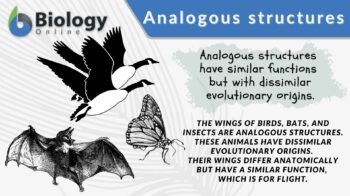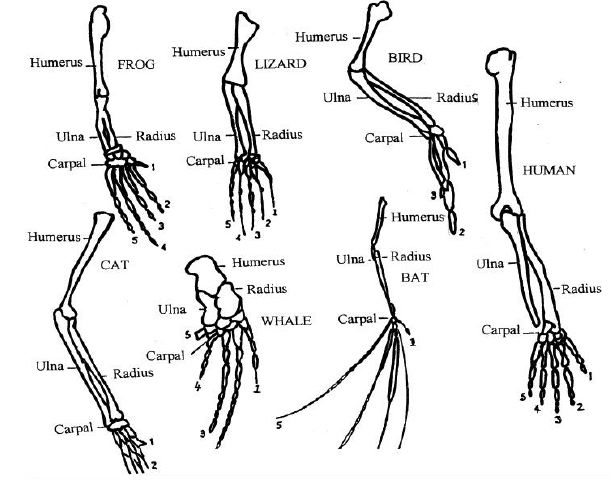
Analogous structures
n., singular: analogous structure
[əˈnæl.ə.ɡəs ˈstɹʌk(t)ʃɚs]
Definition: Structures that have similar functions but with dissimilar evolutionary origins
Table of Contents
Analogous Structures Definition
In evolutionary biology, analogous structures are biological structures having similar or corresponding functions but not from the same evolutionary origin. In other words, species use these biological structures for the same purpose and yet these species are from unrelated evolutionary lines.
This form of evolution is referred to as convergent evolution. Convergent evolution is a kind of evolution wherein organisms evolve structures that have similar (analogous) structures or functions in spite of their evolutionary ancestors being very dissimilar or unrelated.1, 2, 3 Thus, analogous structures of unrelated species would have similar or corresponding functions although they evolved from different evolutionary origins.
Examples of Analogous Structures
The wings of a bird and of an insect are analogous organs. Both of these species have wings that they use for flight and yet their wings came from dissimilar ancestral origins. The popular theory as to the evolutionary origin of birds is the therapod dinosaurs, specifically, members of Maniraptora.4
As for the insects, the evolutionary origin remains obscure. How the insect flight evolved remains unclear. One of the popular thoughts, paranotal hypothesis, suggests that their wings developed from the paranotal lobes of the thoracic terga. Based on phylogenomic analyses, winged insects possibly evolved from a terrestrial rather than from an aquatic ancestor.5
Considering the cited example, analogous structures need not be of the same structure. In general, the wings of birds are modified forelimbs. Their forelimbs are comprised of the bones: humerus, ulna, and radius. These bones, just like the rest of the bird skeleton, are lightweight. This is, in fact, one of the essential features of birds capable of flight. They contain air sacs and most of them are hollow bones to reduce weight.
Another adaptation of wings that enables flight is the presence of flight feathers at the outermost. The feather anatomy provides the bird its first lift, and then its true powered flight. As for the insects, their wing is an outgrowth of the exoskeleton located on the mesothorax and the metathorax. The paired wings arising from the mesothorax are called forewings whereas those from the metathorax are called the hindwings.
Their wings do not have a bony structure like the wings of the birds. Rather, the insect wings are comprised of veins that criss-cross, and within each of the major veins are a nerve, a trachea, and flowing hemolymph. A cuticle surrounds the veins to thicken and provide structural support to the insect wing. And instead of feathers, the insect wing has hairy structures of two major types: microtrichia (finer) and macrotrichia (larger).
Apart from the bird wings and the insect wings described above, here are other analogous structures examples:
- The complex eyes of vertebrates, cephalopods (squid and octopus), cubozoan jellyfish, and arthropods (insects, spiders, crustaceans) evolved separately. Nevertheless, their eyes are, essentially, for the function of vision.
- The very similar shells of brachiopods and bivalve mollusks
- The plant hormones such as gibberellin and abscisic acid of plants and fungi
- The organs for smell are an example of analogous organs. An analogous organ pertains to an organ that functions similarly to the organ from another yet evolutionary disparate species. The smelling organs of the terrestrial coconut crab are similar to the sensilla of insects. Both of them developed similar organs that can detect smells in the air and flick antennae for improved reception.
Analogous Structures vs. Homologous Structures
The structures derived from a common ancestor or from the same evolutionary or developmental origin are referred to as homologous structures. Homologous structures may not necessarily perform the same function. An example of homologous structures is the forelimbs of humans and bats.
The forelimbs of both humans and bats have the same fundamental skeletal structure, derived from the same embryonic origin, and evolved from the same structures. Both of them are of mammalian origin. However, their forelimbs are used differently. The bats use their forelimbs for flight.
Similar to other mammals, the major component of the bat forelimb is the radius. The digits, though, are relatively elongated, radiating around the wrist and webbed. The membrane, called a patagium, is the delicate membrane that stretches between the arm and the finger bones. The membrane is an extension of the skin comprised of muscles, nerves, blood vessels, and connective tissues.
In contrast to homologous structures, the analogous structures are those showing similar functions but evolve separately. These structures from different species do not share a common ancestor such as the fins of fish and flippers of whales (mammals) are analogous structures of evolutionary unrelated animals that use them for swimming. The analogous structures may be dissimilar with regard to anatomy whereas the homologous structures may show similar anatomical features. In terms of development patterns, homologous structures show similar patterns whereas analogous structures do not.
In order to determine if a structure is analogous to that of another species, one could look at their common lineage. Analogous structures, as pointed out earlier, are structures having a similar or corresponding function but the two species under probe should not share the same evolutionary origin.

Watch this vid on homologous vs. analogous structures:
The Evolutionary Process
Convergent evolution is the evolutionary process wherein organisms evolve analogous structures (or functions) in spite of their ancestors being very dissimilar or unrelated. To be considered analogous, the structures between the two species have to have the same function but they do not necessarily have the same anatomical features. Because analogous structures differ in anatomy as well as developmental origin they do not implicate a common ancestral origin. The features or traits common in them evolve independently.
What produces analogous structures is associated with how the species adapt to a similar environment. For instance, the smelling organ of the coconut crab differs remarkably from the other crabs but resembles more closely the sensilla of insects.6, 7
The analogous structures are a result of their similar terrestrial mode of life. As opposed to the crabs that live in an aquatic habitat, the coconut crab spends more time on land, tracking food sources (e.g. smell of rotting meat) over long distances with their well-developed sense of smell. The same habitat and the same ecological niche could drive analogous structures to evolve between species of different lineages by presenting the residing species with the same environmental factors and constraints.
Analogous structures provide evidence for evolution through the existence of analogous structures, this implicates that the species evolve in response to their environments and as a measure of their capacity to fit in or survive. They may have developed an anatomically similar structure as those from the same lineage but the function may well serve another purpose that suits their ecological niche. Analogous structures are an indication that unrelated species evolve somehow similarly and yet independently.
Answer the quiz below to check what you have learned so far about analogous structures.
Further Reading
References
- Convergent Evolution: Recurrence of Form Tree of Life : Exhibits : Yale Peabody Museum of Natural History. (2015, June 12). Retrieved from Yale.edu website: Link
- Convergent Evolution. (2019). Retrieved September 3, 2019, from Utexas.edu website: Link
- Evolution Theory and Science. (2019). Retrieved September 3, 2019, from Berkeley.edu website: Link
- Prum, R. O. (19 December 2008). “Who’s Your Daddy?”. Science. 322 (5909): 1799–1800.
- Wipfler, B. et al. (19 February 2019). “Evolutionary history of Polyneoptera and its implications for our understanding of early winged insects”. Proceedings of the National Academy of Sciences. 116 (8): 3024–3029.
- BBC NEWS Science/Nature Pilfering crab has insect’s nose. (2009). Retrieved from Bbc.co.uk website: Link
- Coconut crab. (2019). Retrieved from Mcgill.ca website: https://www.cs.mcgill.ca/~rwest/wikispeedia/wpcd/wp/c/Coconut_crab.htm
© Biology Online. Content provided and moderated by Biology Online Editors



